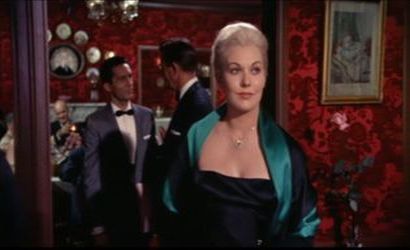The MacGuffin: News and Comment (24/Nov/2007)
(c) Ken Mogg (2007)
November 24
We discussed the moment from Vertigo shown below, in which 'Madeleine Elster' pauses in the lobby of Ernie's Restaurant, on our Yahoo group recently. Beside her is a trompe l'oeil painting showing a child - but which, from a slightly different angle, shows the child grown into a woman, and, from a different angle again, the child become an aged, wizened crone! (This information was provided by group member 'Charley' - whom I thank.) Let's notice a few other things about the moment. It is essentially a subjective shot from inside Scottie's consciousness, as he watches (is aware of) Madeleine from the Ernie's bar. The image is full of upright, vertical objects, including the door jambs in the foreground and background, the painting in its frame, and, below it, a single slender rose in a tall vase. Not entirely accidental is the fact that the door jambs are made of wood - redwood, which will figure in several other key scenes - nor the fact that the walls themselves are a rich red, almost a blood red, thus doubly signifying 'life' (which is part of the very subject of Vertigo, where, however, it is never separable from 'death', something I'll come back to). Now notice the scene's several pendant objects: the emerald below Madeleine's neck, the crystal chandelier, the picture. Pendant objects are something else that recur throughout the film, and, like the vertical objects, each time subliminally remind us of the film's title and the moment at the start when Scottie hung suspended from a rooftop (while we, the audience watched in a suspense of our own ...). The actual colour-scheme of the moment shown here has its further subtleties, not least the general artificiality of it: remove Madeleine from the shot and the effect is stark and unpleasant! Madeleine's emerald wrap (echoing the colour of her pendant) is complemented (set off) by the pink rose; the latter, in turn, is complemented (set off) by both the deep red of the wall and by the rose's green leaves. The whole frame is an art-work, itself full of works of art or lovingly crafted objects. (Not for nothing will Scottie refer to how Gavin made Judy over, into the false Madeleine ...) So what is going on here? If you will, we are being given the entire film in miniature! I'll do my best in the space remaining to indicate how that is. Take the emphasis on art, artificiality, and, above all, trompe l'oeil. That is the nature of Vertigo, with its related emphasis on appearance-versus-reality. In the original novel, the theme of 'art' is related especially to the Scottie character (there is no Midge character), someone who is 'never quite the artist', though he would like to have been (cf Brandon in Hitchcock's Rope). That theme is being echoed here, in Scottie's yearning consciousness. Again, the trompe l'oeil painting on the wall speaks of ephemerality (and of the difference time and space make to our perception ...), and this is related visually (i.e., in the film's frame) to both the pristine rose and to the exquisite 'Madeleine' herself. In their all-too-fleeting beauty, they are momentarily equated. Yet of course humans seek constantly to overcome, or transcend, the ephemeral, to find, or create, truth and beauty that endure. For a time (!), 'Madeleine'/Judy will become Scottie's art-object whom he tries desperately to 'make' and 'possess' and to 'keep', especially as she herself seems to possess (the secret or 'key' to) 'life' itself, to be the Eternal Feminine incarnated (cf the title-character of Hitchcock's never-made Mary Rose). How vertiginous! Now notice again that rose, Madeleine's flower (cf the nosegay from Podesta's flower shop). Madeleine is like Scottie's 'Rosebud' à la Citizen Kane but also like the actual rosebud in the vase, which is 'perfect' for a time (!) and then wil be replaced by another, which in turn will be replaced, and so on. The rose's tall stem, with its dark green leaves, may remind us of the tall Sequoias ('always green, ever-living') in the forest scene, though, paradoxically, that scene is very dark and 'chthonic', and altogether the inverse of the Ernie's scene. Significantly, 'Madeleine' (or rather Carlotta speaking through her) is associated with the felled Sequoia ('Here I was born and here I died') - whose cross-section with its rings is itself an echo of the rose at Ernie's and all the other 'concentric circles' imagery (the nosegay, for example). But also, in the same scene, she leans back against one of the massive trunks of the growing trees, appealing to Scottie's, and her own, yearning to transcend, to be 'free'. In turn, that whole scene, and the one at Ernie's (where Scottie first sees 'Madeleine'), relate to Scottie's moment on the rooftop, looking down - virtually at his own death. So the blood-red of the walls at Ernie's may be a subliminal reminder of that 'death', yet the Ernie's scene itself is all about 'life'. My conclusion (with some indebtedness to Charles Barr): Scottie perched at the bar may really be still back on the rooftop, or already falling off it, seeing in a flash what 'life' is - namely, 'colour, excitement, power, freedom', and somehow beyond, yet incorporating, all those things, 'Madeleine' - but also that he must now die. And perhaps, next moment, after clinging to the roof, he had indeed fallen, and the film itself represents an illusion, a simulacrum, of perpetual 'life', imagined in exquisite slow-motion but really in a flash, inside Scottie's head, as he plummets into pain and blood and darkness ...
This material is copyright of Ken Mogg and the Hitchcock Scholars/'MacGuffin' website (home page) and is archived with the permission of the copyright holder. |

